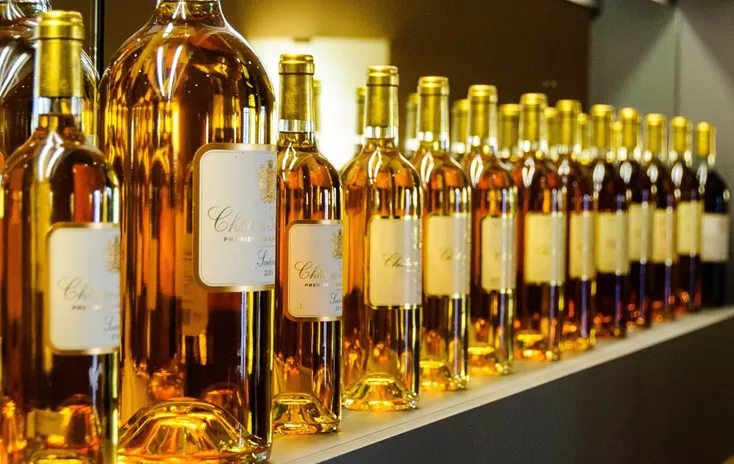Sauternes is one of the most famous and prestigious sweet wines in the world, originating from the Bordeaux region of France. Known for its luxurious golden hue and complex flavors of honey, apricots, and nuts, Sauternes is a wine that stands out due to its unique production process. The secret behind its rich and luscious profile lies in the grape varieties used and the role of noble rot (Botrytis cinerea), which concentrates the sugars and enhances the wine’s depth.
This article explores the primary grape varieties used in Sauternes, their individual contributions to the final blend, and how they interact to create the world-renowned Sauternes wine.
The Main Grapes Used in Sauternes
Sauternes is traditionally made from a blend of three main grape varieties:
Sémillon
Muscadelle
Each of these grapes plays a crucial role in shaping the character of Sauternes. Let’s examine them individually.
Sémillon: The Backbone of Sauternes
Characteristics of Sémillon
Sémillon is the dominant grape in Sauternes, often accounting for around 80% of the blend. This white grape variety is known for its thick skins, which make it particularly susceptible to noble rot, the key factor in Sauternes’ production.
Key Contributions to Sauternes
Richness and Body: Sémillon provides the lush, creamy texture that makes Sauternes so velvety on the palate.
Aging Potential: Due to its high glycerol content and structure, Sémillon-based Sauternes can age for decades, developing complex flavors of dried fruit, nuts, and honey.
Botrytis Susceptibility: Sémillon is particularly prone to noble rot, which enhances its sugar concentration and unique flavors.
Flavors in Sauternes
When affected by noble rot, Sémillon develops flavors of:
Honey
Apricot
Marmalade
Toasted almonds
Butterscotch
Sauvignon Blanc: Adding Freshness and Acidity
Characteristics of Sauvignon Blanc
Sauvignon Blanc is the second most important grape in Sauternes, usually comprising about 15-20% of the blend. This grape is renowned for its bright acidity and vibrant aromas, which help balance the richness of Sémillon.
Key Contributions to Sauternes
Acidity and Structure: Sauvignon Blanc brings refreshing acidity, preventing the wine from becoming overly heavy.
Aromatic Complexity: It adds citrus and floral notes, enhancing the overall bouquet.
Balance: The crispness of Sauvignon Blanc ensures that Sauternes remains lively despite its high sugar content.
Flavors in Sauternes
Sauvignon Blanc contributes flavors such as:
Lemon zest
Grapefruit
Fresh grass
Elderflower
Green apple
Muscadelle: The Aromatic Enhancer
Characteristics of Muscadelle
Muscadelle is the least-used grape in Sauternes, typically accounting for only 5% or less of the blend. Though it plays a minor role, its impact on aroma and flavor is significant.
Key Contributions to Sauternes
Floral Notes: Muscadelle enhances the aromatic profile with delicate floral hints.
Complexity: It adds subtle spice and exotic fruit notes, enriching the wine’s character.
Early Maturation: Unlike Sémillon and Sauvignon Blanc, Muscadelle tends to ripen earlier, which can influence harvesting decisions.
Flavors in Sauternes
Muscadelle imparts:
White flowers
Orange blossom
Exotic spices
Lychee
Jasmine
The Role of Noble Rot in Sauternes
The presence of Botrytis cinerea, also known as noble rot, is what makes Sauternes truly unique. This fungus thrives in the humid mornings and dry afternoons of the Sauternes region, causing the grapes to shrivel and concentrate their sugars.
Effects on the Grapes
Water Evaporation: Noble rot dehydrates the grapes, intensifying their sugar and acidity levels.
Flavor Development: It introduces complex flavors like saffron, ginger, and honey.
Glycerol Increase: Enhances the wine’s mouthfeel, giving it a luxurious, silky texture.
The Perfect Blend: Balancing Sweetness and Freshness
The combination of Sémillon, Sauvignon Blanc, and Muscadelle creates a perfectly balanced Sauternes:
Sémillon provides body and richness.
Sauvignon Blanc ensures freshness and acidity.
Muscadelle enhances aroma and complexity.
The interplay between these three varieties, along with the effects of noble rot, results in a wine that is both decadently sweet and beautifully structured.
Notable Sauternes Producers and Vineyards
Several estates in Bordeaux are renowned for producing exceptional Sauternes:
Château d’Yquem – The most prestigious Sauternes producer, known for its incredible depth and longevity.
Château Rieussec – A highly respected estate producing classic Sauternes.
Château Suduiraut – Known for its elegant and floral expression of Sauternes.
Château Guiraud – An organic-certified Sauternes producer with a focus on sustainability.
Food Pairings with Sauternes
Sauternes pairs exceptionally well with:
Foie gras – The rich, buttery texture complements the wine’s sweetness.
Blue cheese – The saltiness balances the sugar content.
Crème brûlée – A perfect dessert match.
Spicy Asian cuisine – The sweetness counteracts spice.
Roast chicken with honey glaze – Enhances the dish’s caramelized flavors.
Conclusion
The magic of Sauternes lies in its blend of Sémillon, Sauvignon Blanc, and Muscadelle, each contributing its own distinct characteristics. Sémillon provides richness and structure, Sauvignon Blanc adds freshness and acidity, and Muscadelle enhances the aromatic complexity. Combined with the effects of noble rot, these grapes create a wine that is unmatched in depth, elegance, and longevity.
Understanding the grape composition of Sauternes allows wine lovers to appreciate its nuances and complexity, making it one of the most cherished sweet wines in the world. Whether enjoyed on its own or paired with exquisite dishes, Sauternes remains a testament to the artistry of winemaking.
You Might Be Interested In:


